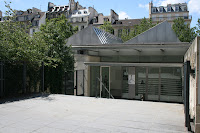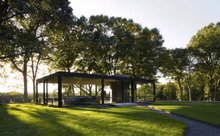
I did manage, however, to visit Atelier Brancusi, the reconstructed studio of Constantin Brancusi, who as I said in a previous blog entry, donated his property to the French government upon his death in 1957. The building was designed by Renzo Piano (one of the architects who designed the Pompidou Museum) and sits in the Place Georges Pompidou adjacent to the museum, so it is a must see when visiting this center for modern art. Modern enthusiasts will be happy to know that the Atelier Brancusi is free to visit, offering sun bathers, musicians and roaming tourists who congregate in the square a great opportunity to see some of Brancusi’s most celebrated works. I personally found the miniature museum fascinating because it reveals the painstaking detail with which Brancusi placed his sculptures and tools around his studio. To me, the sculptures and array of materials (wood, marble, iron and bronze) synthesize into a single, architectural form that seems almost as if they were the walls and ceiling. While each work is great by itself, the unified amalgamation of objects had a greater effect on me.

I also visited “Paris Plages” – a section on the right bank of the Seine where, since 2002, the French government sets up of five kilometers of beach-like activities during the summer. In 2006, four million people visited the site, enjoying boardwalks, beaches, rock climbing, lounge chairs, water activities, rollerblading, dance studios, cafés and miniature amusement parks. This year, it is just the same. It was a strange feeling to be in the middle of urban Paris and see hundreds of sunbathers along the Seine and children building sand castles modeled after Notre Dame (though it is quite fun none the less). I even saw one man become so inspired by the lively atmosphere that he jumped into the Seine, then quickly scurried up the riverbank wall and vomited all over himself. The Seine is rather polluted, I guess.

-Ian
Philip Johnson Glass House Intern

No comments:
Post a Comment